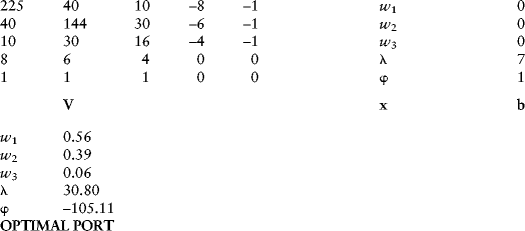Liability-Driven Investment
Let's switch gears a bit and think about hedging the risk of not being able to meet our liabilities. This risk arguably poses the greatest challenge to pension plans. In a recent paper, Robert Novy-Marx and Joshua Rauh (2010) estimate that liabilities exceed assets across the pension plans of the 50 states in the United States by approximately $1.27 trillion using Muni rate discounting and $3.26 trillion using Treasury discounting. Either way, there is a serious underfunding of these liabilities. Pension boards are grasping for investment strategies that hedge the risk of not meeting their liabilities, hence, the concept of liability-driven investment (LDI). As we shall see further on, LDI strategies change the objective function from one of solving for the mean variance efficient portfolio of assets to finding the mean variance efficient portfolio that maximizes the surplus return. The surplus return is the weighted return on assets over the growth rate of liabilities. Thus, the problem is set up with a slightly different optimization objective but is otherwise solved as before. Let's develop this problem in detail, solve it, and then examine the properties of the solution as a hedging strategy.
The mathematics of this particular problem can get complicated and I defer treatment of the problem to Michael Bazdarich's paper (2006). I present instead an applied version of the problem that we'll study as a spreadsheet exercise. But first, let's set the problem up and examine its first order conditions. I will use Bazdarich's notation.
Basically, we want to find the portfolio w that maximizes surplus return given by (w′x – ρ/F), in which:
The surplus variance (the variance of w′x plus the variance of L/F plus two times their covariance) is:
![]()
We want to solve for the portfolio that minimizes this variance subject to the usual constraints. That is,
![]()
![]()
M is the targeted return on the portfolio and i is a vector of ones to satisfy the fully invested constraint.
We can set this problem up as the Lagrangian:
![]()
Taking derivatives with respect to the N weights plus the Lagrange multipliers, λ and ϕ, setting these N + 2 first order conditions equal to zero and solving yields the minimum variance portfolio.
Let's take the case of a two-asset portfolio like stocks (w1) and bonds (w2). In this case, we will have the following four first-order conditions to solve:
![]()
![]()
![]()
![]()
We can rewrite this system in matrix form as follows to facilitate the solution in Excel after substituting values.

If we label this system Vx = b, then the solution is V−1b = x. The spreadsheet for this chapter substitutes some hypothetical values for V and b using a three-asset portfolio and solves for the optimal portfolio that is presented further on.
This first case has zero covariances between liability growth and the assets’ returns. Therefore, it is the standard asset-optimal portfolio.

Assume that the three assets are U.S. equity, non-U.S. equity, and Treasury bonds, respectively. The targeted return of 7 percent pretty much freezes Treasuries out of the portfolio in order to meet the return target.
Now, look what happens if we make the third asset return correlated with growth in liabilities.

Because Treasury returns are correlated with liabilities, the optimal portfolio is required to invest in them at the expense of non-U.S. equity and consequently requires a heavier allocation to U.S. equity. LDI in this case sees the correlation between Treasuries and the liabilities and, to hedge liability risk, holds a greater proportion of the Treasuries.
One of the concerns about LDI strategies is that they will force increased allocations to the lower-returning assets, which are correlated more with liabilities. In most cases, this is true—LDI does increase bond allocations because these assets’ returns are more correlated with the growth in liabilities. But in some cases, like the one discussed earlier, it also requires an increased exposure to the risky asset.
